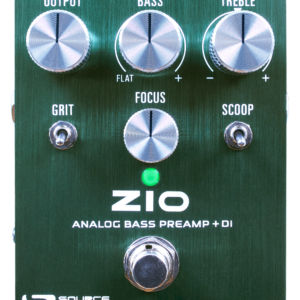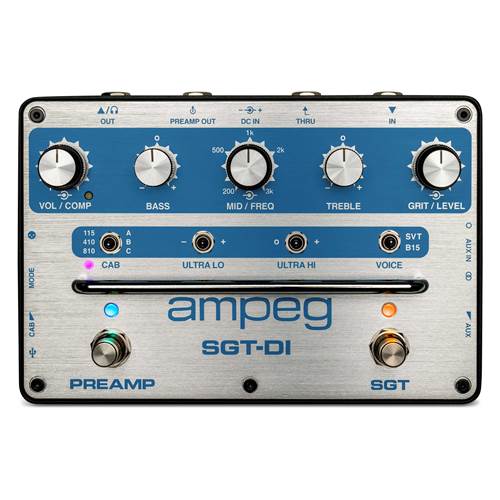Description
The Ampeg SCR-DI Bass DI Preamp with Scrambler Overdrive is currently retailing at £249 and it is in stock. Available to be delivered to you by post direct (some charge may apply). The top pedal chef at Just Pedals thinks that Ampeg nailed it here. Ampeg SCR-DI Bass DI Preamp with Scrambler Overdrive
We have new and used Ampeg musical equipment available on our website for fast direct delivery from sellers across the UK & Europe.
Ampeg is legendary in the world of bass amplification, known for its deep, rich tones and unmistakable vintage warmth. From the iconic SVT series, favoured by professional bassists worldwide, to modern compact options like the Rocket Bass combos, Ampeg delivers powerful, stage-ready sound with that signature punch. Whether you're after classic tube-driven grit or clean, articulate low-end, Ampeg remains a go-to choice for bass players across all genres.
In the realm of guitar effects, "bass" pedals are designed specifically for bass guitars, enhancing their low-end frequencies and allowing bassists to shape their tone and explore new sonic possibilities. These pedals cater to the unique characteristics of the bass guitar and provide various effects to modify its sound. For instance, overdrive and distortion pedals add gain and saturation, giving the bass a gritty or distorted tone. Compression pedals help even out dynamics by smoothing out the volume of loud and soft notes, resulting in a consistent and punchy sound. EQ pedals enable bassists to sculpt their tone by boosting or cutting specific frequencies, allowing them to emphasize certain parts of the sound or compensate for room acoustics.
Other popular bass effects include envelope filters, which produce dynamic filter sweeps in response to playing dynamics, adding rhythmic groove to bass lines. Octave pedals generate harmonies one or two octaves below the original note, creating a fuller and more powerful sound. Modulation effects like chorus, flanger, and phaser add depth and movement by modulating the pitch or phase, creating swirling textures and enhancing the overall presence of the bass line. Lastly, delay and reverb pedals introduce ambience and spatial depth, adding echoes and reflections that enhance the sense of space in music. These diverse effects allow bassists to expand their sonic palette and express their creativity in numerous ways.
Just Pedals is a new Guitar Effect Pedals Marketplace – We feature new and used Guitar Effect pedals from different sellers, to purchase online from the UK.
We checked and good news we have it in stock, it has your name on it.
Order today and we will have it with you in a jiffy !
Overdrive is a popular guitar effect that creates a warm, distorted sound by amplifying the signal of an electric guitar, typically using a pedal or an amp's built-in circuit. The effect simulates the natural distortion that occurs when a tube amplifier is pushed to its limit, creating a rich, harmonic response that adds sustain, warmth, and character to the tone. Overdrive pedals are commonly used to add grit and growl to a clean tone without the harshness of full distortion.
The overdrive effect works by boosting the input signal, causing the amplifier to break up and clip the waveform, resulting in a smooth, musical distortion. This is often more subtle and less aggressive than other forms of distortion, making overdrive pedals ideal for blues, classic rock, and country players who seek a dynamic sound that responds to their playing touch. Overdrive pedals can be used in conjunction with other effects like delay and reverb to shape a more complex, evolving sound. Popular overdrive pedals include the Ibanez Tube Screamer, the Fulltone OCD, and the Boss OD-3, each offering different tonal characteristics, from smooth and bluesy to punchy and aggressive.
A preamp pedal boosts the guitar signal to line level before it reaches an amplifier, shaping the tone and adding warmth, character, or gain. Preamp pedals can be used to simulate the sound of an amplifier’s preamp stage, providing overdrive, distortion, or clean tone shaping. They can also be used to drive amplifiers harder or to add tonal colour and EQ adjustments. Some preamp pedals are designed to mimic classic amp sounds, such as those from Fender, Marshall, or Vox, while others offer more modern, transparent tones. Well-known preamp pedals include the Tech 21 SansAmp, Electro-Harmonix Soul Food, and MXR M81 Bass Preamp, making them a useful tool for tone shaping in both live performances and studio work.
Just the latest videos
Just related products
£17.99
[Power Specifications] Input voltage: AC 100-240V 50/60Hz, extension cord 5 feet. [Wide use] Widely used in hand-washing counters, Halloween decorations, handheld vacuum cleaners, security equipment, liquid crystal displays, LED lights, light-emittin…
read more £215.00
Wide range of authentic Ampeg tones from smooth Portaflex to harmonically-rich SVT The connections you need to drive your rig and deliver your exact tone to front-of-house – XLR balanced line out with ground lift, affected 1/4" output and unafected 1…
read more £18.99
Input: 100-240 VAC 50/60Hz global voltage use power supply PSU Cable length: 150 cm/5 feet, don't worry about the short cable, please check the list of compatible models before placing an order to confirm the output voltage and current of your electr…
read more £19.99
Input: 100 – 240 VAC 50/60Hz Worldwide Voltage Use Mains PSU Peephet Adapter for Ampeg SCR-DI Bass DI Preamp with Scrambler Overdrive Power Safety: Our Products are CE / FCC / RoHS certified, tested by the manufacturer to match and / or exceed the OE…
read more £138.00
2 Channels FET and Tube with Blend Switch 3 Band EQ Low Mid with switchable frequencies DI Out with pre/post source select











![[Power Specifications] Input voltage: AC 100-240V 50/60Hz, extension cord 5 feet. [Wide use] Widely used in hand-washing counters, Halloween decorations, handheld vacuum cleaners, security equipment, liquid crystal displays, LED lights, light-emittin...](https://m.media-amazon.com/images/I/41LRcg88jPS._SL160_.jpg)



